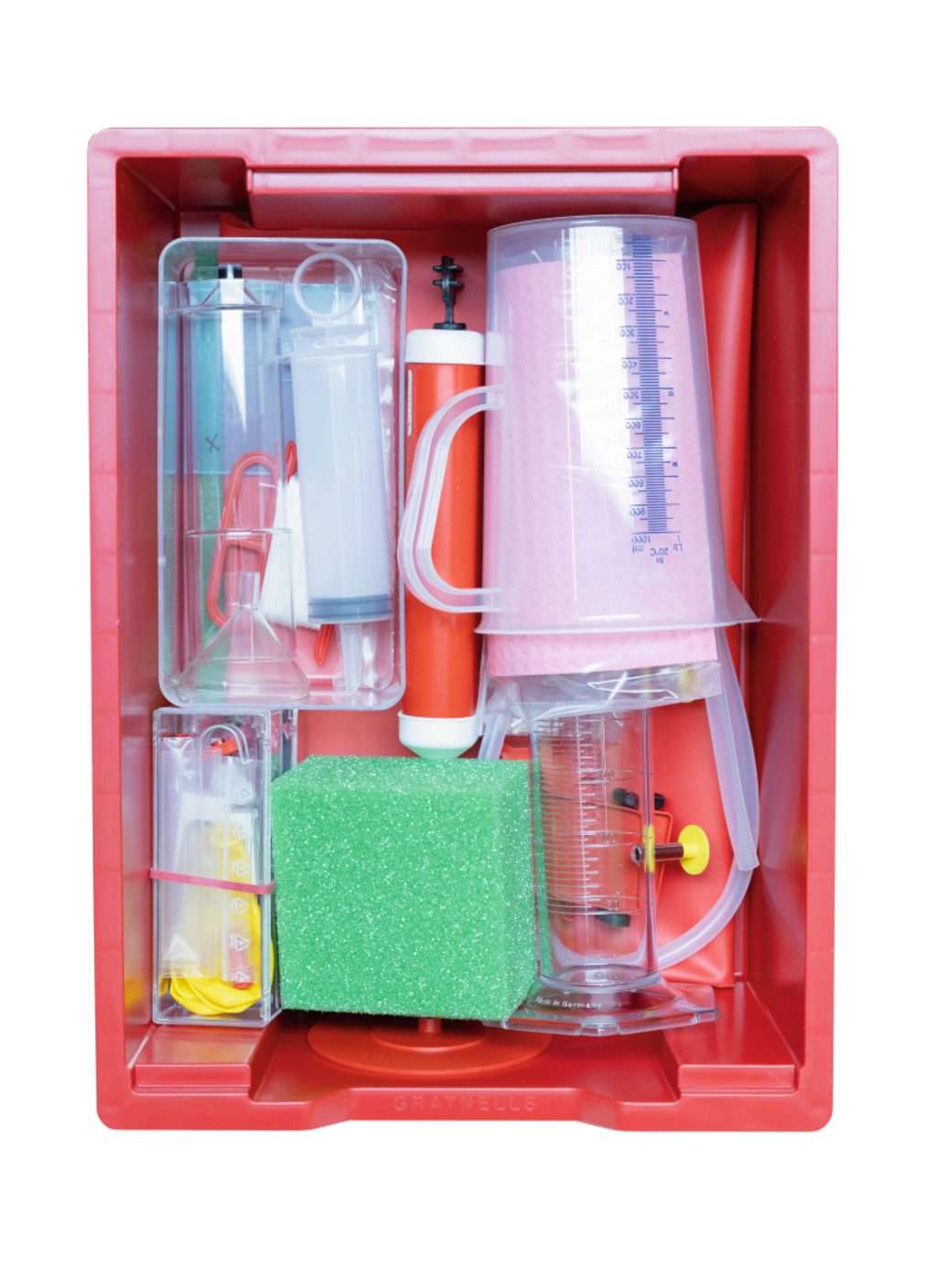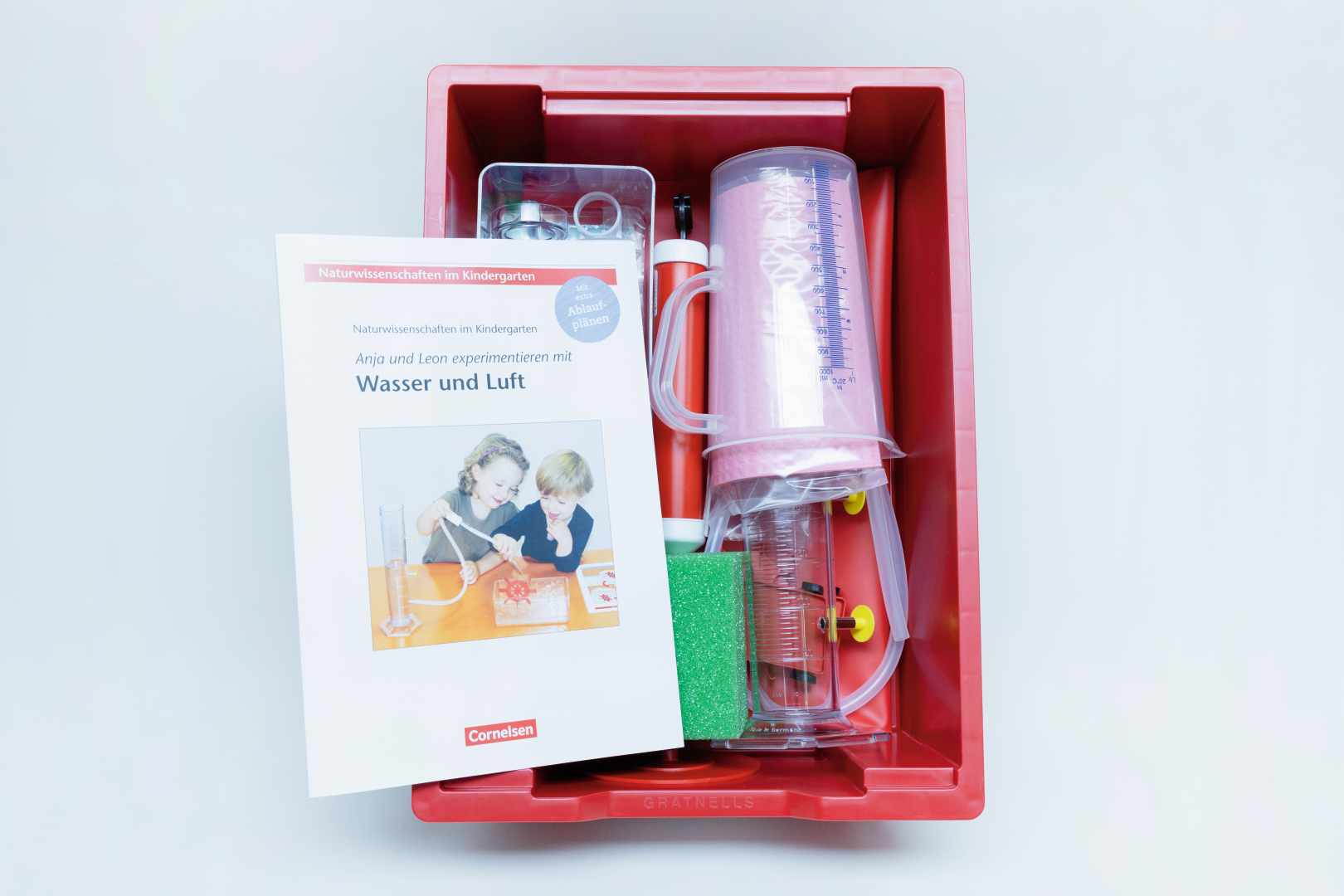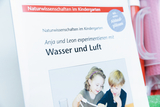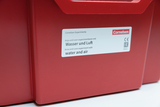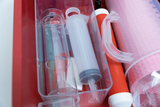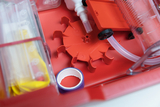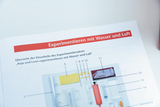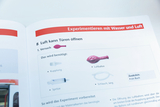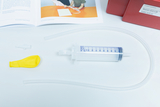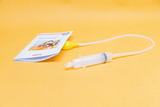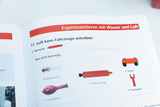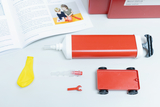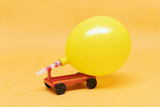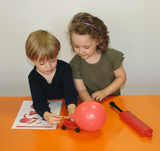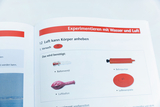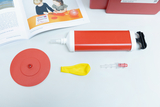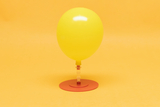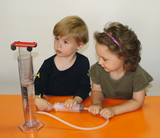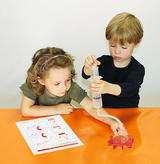Kindergarten kit Anna and Leon experiment with water and air
Water and air – really strong stuff!
Children make keen and observant researchers. They observe their environment very accurately, make assumptions and wish to check those
assumptions on their own.
Here they are given a set of materials with which they can learn all about the phenomena surrounding water and air.
More than 30 exciting experiments allow the children to discover that air and water have many characteristics and are much stronger than one thinks! They will find out for example that air can lift a body or water can power wheels.
The knowledge they have gained will awaken and encourage their interest in natural sciences.
The children should be introduced to the following findings with the help of the experiment:
- Liquids (water) do not have a solid form and can fill free spaces.
- Liquids have a weight and need space (room).
- Liquids, like all bodies, want to fall down (flow).
- Liquids can only rise upward with pressure.
The children should be introduced to the following findings with the help of the experiment:
- Liquids (water) are fluid bodies that occupy space (room) and have a weight.
- Liquids exert pressure on all sides.
- The pressure in liquids increases more and more with depth.
The children should be introduced to the following findings with the help of the experiment:
- Liquids (water) do not have a solid form and can fill free spaces.
- Liquids require space (room) and can displace air from vessels.
- Liquids flow from one vessel to another when two vessels are connected until the liquid level is equal.
- The level in a vessel is independent of the vessel shape.
The children should be introduced to the following findings with the help of the experiment:
- Air is a body that occupies all free spaces.
- Air can be compressed and expanded.
- If air is sucked out of a closed container, the outer air tries to take up this space again with force and pressure.
- These force effects can be used practically.
The children should be introduced to the following findings with the help of the experiment:
- Air can be at rest or in motion.
- Moving air contains energy.
- The energy contained in moving air (wind) can act as a force when it encounters resistance.
The children should be introduced to the following findings with the help of the experiment:
- Liquids (e.g. water) do not have a solid form and can fill free spaces.
- Liquids that are in a sealed vessel require space and cannot be compressed.
- If pressure is exerted on a sealed liquid, the pressure is transferred through the liquid to the walls of the vessel and can take effect elsewhere.
The children should be introduced to the following findings with the help of the experiment:
- Liquids (water) are fluid bodies that can be easily moved and displaced.
- Liquids that are pressurized can also flow upward or faster.
- If the path of a flowing liquid becomes narrower (pipe), the speed of the flow increases.
The children should be introduced to the following findings with the help of the experiment:
- Flowing water can transfer energy.
- To create a flow, water can fall or flow down from a higher position.
- Flowing water can exert a force effect.
- That the flow energy of water can be converted into mechanical energy.
The children should be introduced to the following findings with the help of the experiment:
- Air is a body that occupies all free spaces.
- Air requires space, even if it is not visible.
- Air can displace other bodies, but can also be displaced by other bodies.
- Air is elastic and can be compressed into less space when it is enclosed.
The children should be introduced to the following findings with the help of the experiment:
- Air is a body that occupies all free spaces.
- Air can be moved from one vessel to another by pressure (air pump).
- The energy required to move the air is thereby transferred to the other location.
The children should be introduced to the following findings with the help of the experiment:
- Air is everywhere in space.
- Air can be above, next to and below an object or body.
- If a body falls in space filled with air, it can be slowed down by a cushion of air beneath it.
- The strength of the air cushion depends on the area of the falling body.
The children should be introduced to the following findings with the help of the experiment:
- Air is a body that requires space (room).
- Air is an elastic body that can be compressed in a closed space.
- Air stores the force used to compress it as energy.
- The stored energy can be released and used again.
The children should be introduced to the following findings with the help of the experiment:
- Air is a body that requires space (room).
- Air is an elastic body that can be compressed in a closed space.
- 1 × Waterproof underlay 65x65 cm
- 1 × Plastic tube 120x5 mm
- 1 × Rubber balloons, 100 pcs.
- 1 × Spring-clip
- 1 × Foam cutting 1 for 31764,105x105x55 mm
- 1 × Lidfoam grey,515x355x10mm
- 1 × Air pump for balloons
- 1 × Immersion tube
- 1 × Metal axis, 125 mm
- 1 × Measure, 1000ml
- 1 × Adhesive tape, 10mx19mm
- 4 × Tubular clip, 10 mm
- 1 × Air cushion disc
- 1 × Glass tube, straight, 100 mm with jet
- 1 × Propulsion vehicle
- 1 × Screen translucent, plastic 90x90x1 mm
- 1 × Syringe, 100 ml
- 1 × Parachute with figure
- 1 × Cleaning cloth
- 1 × Trough with two bores
- 1 × Drain vessel with spout 500 ml
- 1 ×
- 1 ×
- 1 ×
- 1 ×
- 2 × Plastic box 140/50/35 mm
- 1 × Silicone tubing, 7/1,5 mmper m
- 1 × Storing tray, deep, red
- 1 × Funnel for the suction flask 47563, 60 mm ø
- 1 × Lid for 75028 + 75038
- 1 × Glass tube, straight, 200 mm
- 1 × String on spool
- 1 × Carton for SEG (large tray)
- 1 × Paddle wheel
- 1 ×
